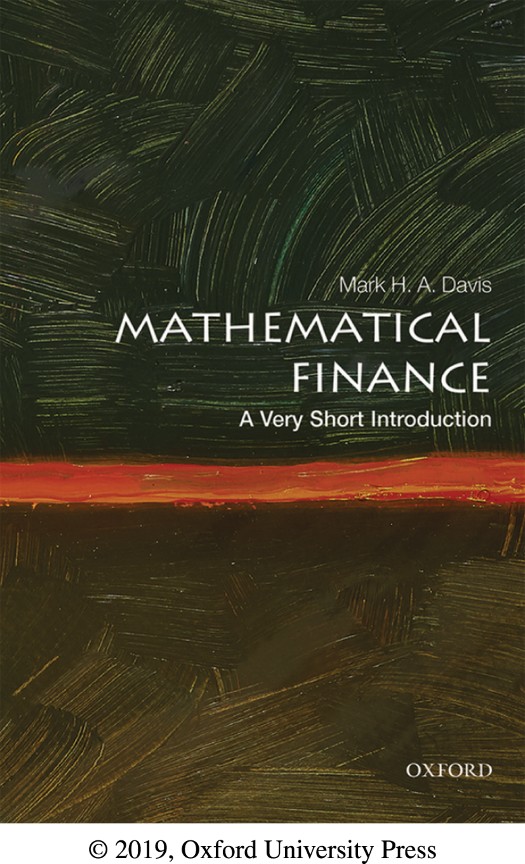
Oxford University Press started its ‘A Very Short Introduction’ series in 1995 and the series now covers over 550 topics ranging (alphabetically) from Abolitionism to Zionism. A book in the series on Mathematical Finance is overdue and Mark Davis has done an excellent job filling that gap in a mere 124 pages.
There are eight chapters that survey the field. The assumption is that the reader is starting with minimal knowledge. Chapter 1 covers money, banking and the financial markets. It explains money supply, bonds, equities, forwards, futures, and options. The title of Chapter 2 is ‘Quantifying Risk’. Here the reader is introduced in a few pages to random variables, normal distributions, means, standard deviations, the central limit theorem, and even stochastic volatility. Chapter 3 covers option pricing. It explains the binomial model and risk-neutrality. It then moves on to cover the Black-Scholes model (without any dz's or dw's) as well as Greek letters such as delta, gamma, and vega. Finally it touches on volatility surfaces and even talks about Dupire's model.
Chapter 4 covers interest rates. It explains yield curves, caps and swaptions. It reviews short rate models as well as the BGM and LMM models. Chapter 5 is titled Credit Risk. After providing some background it explains structural and reduced form models. Along the way Poisson processes are covered and the problem of quantifying default correlation is examined. The final part of the chapter covers CDOs. Chapter 6 is about fund management and covers Markowitz and its extensions. Chapter 7, which is titled Risk Management, covers value at risk, coherent risk measures, and expected shortfall. Chapter 8 discusses the 2008 crisis and its aftermath.
Mark Davis has a gift for explaining complex ideas clearly and succinctly. Although a huge amount of material is covered the style is fairly relaxed and the material is peppered with interesting historical anecdotes.
The ‘very short introductions’ are billed by Oxford University Press as ‘a stimulating accessible way into a new subject’. In the case of some subjects, it may be possible to move someone from zero knowledge to an understanding with a very short introduction. I have my doubts about whether this is possible with a technical area such as mathematical finance. I think the book will be most useful to people who already have some training in mathematical finance. Indeed, I think that all students and practitioners would benefit from the author's perspectives on the historical development of our field.
Additional information
Notes on contributors
John Hull
John Hull is the Maple Financial University Professor of Derivatives and Risk Management at the Joseph L. Rotman School of Management, University of Toronto. He has written four books: Machine Learning in Business: An Introduction to the World of Data Science (just published); Risk Management and Financial Institutions (now in its 5th edition); Options, Futures, and Other Derivatives (now in its 10th edition); and Fundamentals of Futures and Options Markets (now in its 9th edition). The books have been translated into many languages and are widely used in trading rooms throughout the world, as well as in the classroom. Dr Hull is co-director of Rotman's Master of Finance and Master of Financial Risk Management programs. In addition to the University of Toronto, he has taught at York University, University of British Columbia, New York University, Cranfield University, and London Business School.
